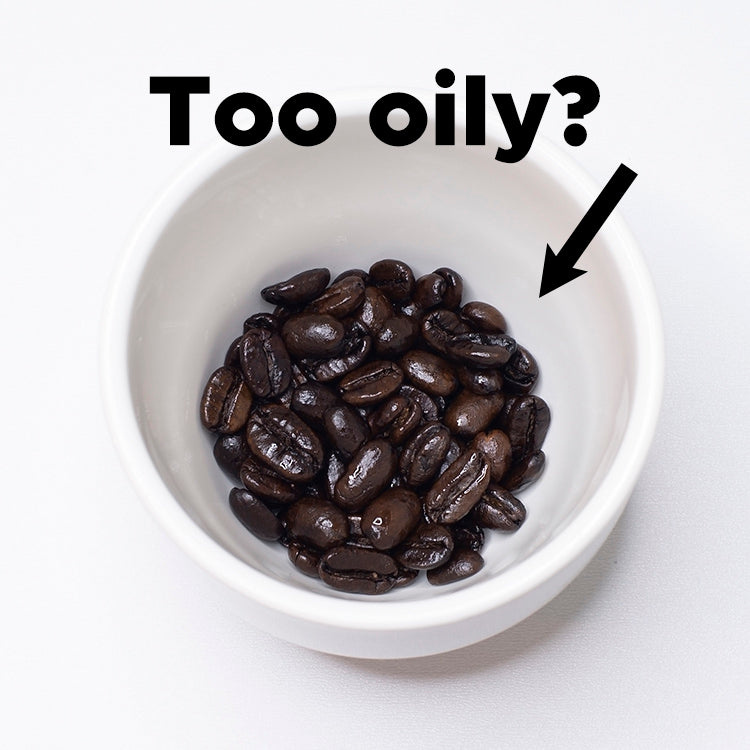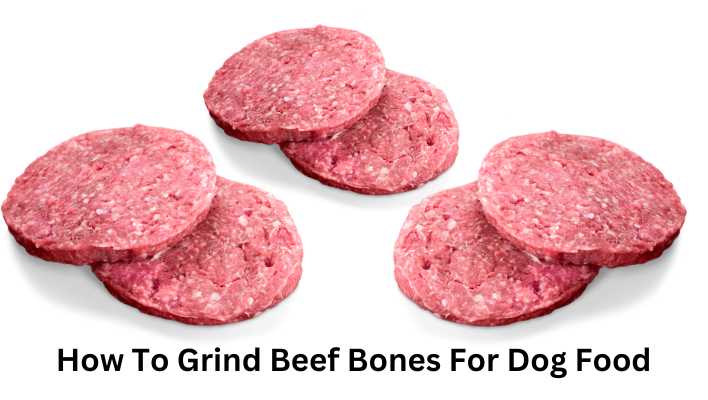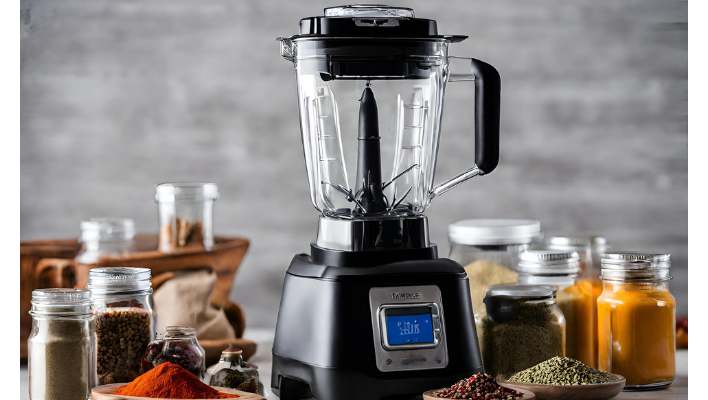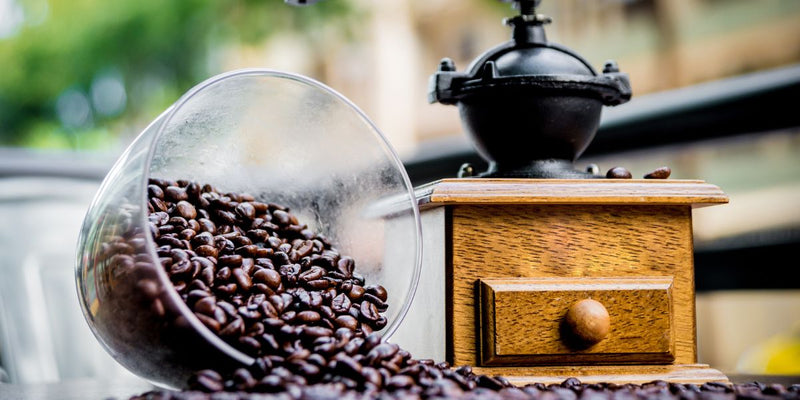Oily coffee beans can negatively affect your grinder’s performance and cause clogging issues.
Understanding The Composition Of Oily Coffee Beans
Coffee beans contain natural oils that can vary depending on the roast level and type of bean. Oily coffee beans are characterized by a shiny surface and a thicker texture due to the presence of these oils. The oils in coffee beans contribute to the flavour and aroma of the brewed coffee but can also have an impact on the performance of your coffee grinder.
How Oily Coffee Beans Affect The Performance Of Grinders
When oily coffee beans are ground, the oils can build up and coat the internal components of the grinder. This can affect the grinder’s ability to grind the beans consistently and can lead to clogging and jamming. The oils can also accumulate on the burrs or blades of the grinder, potentially reducing their efficiency and affecting the quality of the grind.
Additionally, the oils in the coffee beans can create a sticky residue that may be difficult to clean from the grinder. Over time, this residue can build up and affect the overall performance and lifespan of the grinder.
Read Also: Can You Grind Coffee Beans by Hand
To mitigate these issues, it is important to properly maintain and clean your coffee grinder, especially when using oily coffee beans. Regularly removing the oils and residue from the grinder’s components can help optimize its performance and ensure a consistent grind.
Here are a few tips to keep your grinder in top shape when working with oily coffee beans:
- Grind only what you need: Grinding coffee beans in small batches will help reduce the chances of oil buildup and prevent excessive residue.
- Clean your grinder regularly: Use a brush or a clean cloth to remove any visible oils or residue from the burrs or blades of the grinder. You can also use a dry rice or coffee grinder cleaning product to absorb excess oils.
- Avoid using wet or damp beans: Moisture can enhance the stickiness of the oils, making them more likely to accumulate in the grinder. Make sure your beans are dry before grinding.
- Store your beans properly: Oily beans should be stored in an airtight container away from direct sunlight and moisture to maintain their freshness and minimize oil oxidation.
By following these tips and regularly maintaining your coffee grinder, you can ensure optimal performance and prolong the lifespan of your grinder, even when working with oily coffee beans.
Signs Of Grinder Issues Caused By Oily Coffee Beans
Grinder issues caused by oily coffee beans include clogging, inconsistent grind size, and decreased performance. These issues can lead to poor extraction and affect the taste of your coffee.
Identifying Signs Of Grinder Clogs And Malfunctions
Grinding your own coffee beans is a delightful experience that elevates the aroma and flavour of your morning cup. However, if you’ve noticed some issues with your coffee grinder, it could be due to the type of beans you’re using. Oily coffee beans can cause problems for your grinder, leading to clogs and malfunctions that hinder its performance. But how can you identify these potential issues? Let’s take a closer look.
Read Also: How Long Should You Grind Coffee Beans
How Oily Residue Impacts Grinder Functionality
When coffee beans have a high oil content, they can leave behind a residue that can wreak havoc on your coffee grinder. This oily residue can accumulate over time and affect the grinder’s ability to operate smoothly. Here are some ways that oily coffee beans can impact the functionality of your grinder:
- 1. Clogs: Oily residue can cause particles to stick together, creating clogs in the grinder’s burrs or chute. This can result in uneven grinding or no grinding at all.
- 2. Malfunctions: The build-up of oil can lead to gear jams or motor overheating, causing your grinder to malfunction or stop working altogether.
- 3. Decreased Efficiency: The presence of oily residue can cause the grinder to work harder than it should, reducing its efficiency and potentially shortening its lifespan.
- 4. Unpleasant Odors and Taste: Oily residue can also leave behind unwanted flavors and aromas in your coffee, diminishing the quality of your brew.
It’s crucial to be aware of these signs of grinder issues caused by oily coffee beans. By recognizing these red flags, you can take proactive steps to prevent further damage and maintain the longevity of your coffee grinder.
Now, let’s dive into each of these signs in more detail.
Potential Damage To Grinders From Oily Coffee Beans
Oily coffee beans can potentially damage grinders, causing clogs and affecting performance. It is important to clean and maintain the grinder regularly to prevent any long-term damage.
Long-term Effects Of Oily Coffee Beans On Grinder Lifespan
Oily coffee beans may have a negative impact on the lifespan of your coffee grinder. The oils present in the beans can accumulate over time and cause various issues that can affect the grinder’s performance and functionality. It’s important to understand the potential long-term effects of using oily coffee beans to ensure you can maintain the longevity of your grinder.
Common Grinder Components Prone To Damage From Oily Beans
When oily coffee beans are used frequently, certain grinder components are more susceptible to damage. These components play a vital role in the grinding process and can be affected by the oils present in the coffee beans. Here are some common grinder components that are prone to damage:
| Component | Potential Damage |
|---|---|
| Burrs | The oils from the coffee beans can cause the burrs to become coated, resulting in decreased grinding performance and potential clogging. This can lead to uneven grinding and a reduction in the quality of your coffee. |
| Hopper | The oils can accumulate in the hopper, leading to a buildup of residue. This can affect the flow of the beans and cause them to stick, resulting in an inconsistent grind size and potentially causing blockages in the grinder. |
| Chute | The oils can cause the coffee grounds to stick to the chute, resulting in a slower and less efficient dispensing of the grounds. This can lead to clogging and difficulties in cleaning the grinder. |
It is important to keep these components clean and free from oil buildup to ensure optimal grinder performance and durability. Regular cleaning and maintenance can help minimize the potential damage caused by oily coffee beans.
By understanding the potential long-term effects of oily coffee beans on a grinder’s lifespan and being aware of the components that are prone to damage, you can take the necessary steps to maintain your grinder’s performance and ensure a consistent grind for your coffee brewing.
Read Also: Can You Grind Coffee Beans in a Cuisinart
Preventing And Addressing Grinder Problems With Oily Beans
Oily coffee beans can pose a challenge to coffee grinders, leading to clogs and residue buildup. However, with proper preventive measures and regular cleaning and maintenance, you can ensure that your grinder stays in top shape, even with oily beans. In this section, we will discuss some best practices for preventing clogs and residue buildup, as well as provide cleaning and maintenance tips to address oily bean residue. By following these guidelines, you can enjoy a consistently smooth and flavorful coffee experience.
Best Practices For Preventing Clogs And Residue Buildup
Prevention is key when it comes to dealing with oily beans in your coffee grinder. By implementing these best practices, you can minimize the risk of clogs and residue buildup:
- Grind less oily beans in between oily ones: If you’re using a mix of oily and non-oily beans, it can be helpful to grind a small amount of non-oily beans in between to help prevent oil buildup.
- Adjust grind size: Fine grinding settings can be more susceptible to clogging with oily beans. Consider adjusting your grind size slightly coarser to reduce the likelihood of clogs.
- Avoid excessive heat: Excessive heat can worsen oiliness and contribute to clogs. Ensure that your grinder doesn’t get overheated during the grinding process.
- Store beans properly: Store your oily beans in airtight containers to prevent oil from evaporating and degrading the flavor. Additionally, avoid exposing them to direct sunlight or excessive moisture.
- Regularly clean your grinder: Cleaning your grinder after each use is essential for preventing oil buildup. Refer to the next section for cleaning tips.
Cleaning And Maintenance Tips For Oily Bean Residue
Regular cleaning and maintenance are crucial for keeping your grinder running smoothly when dealing with oily bean residue. Here are some tips to help you effectively remove oil buildup:
- Use a brush: After each use, brush away excess coffee grounds and oil residue from the grinder’s burrs, chute, and other accessible parts. Make sure to use a brush specifically designed for coffee grinder cleaning.
- Remove and clean burrs: Periodically remove the burrs according to your grinder’s instructions and clean them using a gentle cleaning solution or coffee grinder cleaning tablets. Rinse thoroughly and dry before reassembling.
- Use rice or grinder cleaning pellets: Running a small amount of uncooked rice or specialized grinder cleaning pellets through your grinder can help absorb excess oils and remove residue. Be sure to check your grinder’s manual for compatibility.
- Wipe down the exterior: Don’t forget to wipe down the exterior of your grinder to remove any oil or coffee residue. Use a clean, damp cloth or a mild cleaning solution to keep it looking pristine.
- Regular maintenance: Consider scheduling regular deep cleaning and maintenance sessions for your grinder to ensure optimal performance and longevity.
By following these cleaning and maintenance tips, you can keep your coffee grinder in excellent condition, even when dealing with oily beans. Remember, a well-maintained grinder is essential for maintaining the flavor and quality of your coffee. Happy brewing!
Choosing The Right Grinder For Oily Coffee Beans
When it comes to grinding oily coffee beans, not all grinders are created equal. The excessive oil content in these beans makes them sticky and prone to clogging, resulting in a poor grinding experience. However, with the right grinder, you can still achieve a consistent grind and extract the full flavor from your oily beans. In this article, we will explore the features to consider when selecting a grinder specifically designed for oily coffee beans, as well as provide recommendations for grinders that can handle oily beans well.
Read Also: Breville Coffee Grinder How to Use
Features To Consider When Selecting A Grinder For Oily Beans
Choosing a grinder that is capable of handling oily coffee beans requires considering some key features. These features will ensure that your grinder can effectively process the beans without clogging or compromising the quality of the grind.
Burr Material
When selecting a grinder for oily beans, opt for grinders with ceramic burrs. Unlike stainless steel burrs, ceramic burrs are less prone to accumulating oil residue. This makes them more resistant to clogging and ensures a consistent grind.
Grind Size Adjustability
A grinder with a wide range of grind size adjustability is crucial when dealing with oily beans. Oily coffee beans tend to clump together, especially with finer grind sizes. Having the ability to adjust the grind size allows you to find the optimal setting that prevents excessive clumping and produces a uniform grind.
Easy Maintenance
Regular cleaning and maintenance are essential for keeping your grinder in good condition when grinding oily beans. Look for grinders that are designed with removable parts and easy access to the grinding chamber, allowing for effortless cleaning and maintenance tasks.
Recommendations For Grinders That Can Handle Oily Beans Well
Now that you know what features to consider, here are some recommended grinders that can handle oily coffee beans effectively:
| Grinder | Features |
|---|---|
| 1. Baratza Sette 270 |
|
| 2. Rancilio Rocky |
|
| 3. Baratza Virtuoso+ |
|
By selecting a grinder with the right features and considering the recommendations above, you can ensure that your grinder performs optimally when dealing with oily coffee beans. These grinders are designed to handle the challenges of oily beans while delivering consistent and flavorful ground coffee.
Read Also: How to Grind Espresso Beans Without a Grinder
Frequently Asked Questions For Are Oily Coffee Beans Bad For Grinder
Will Oily Beans Ruin Grinder?
Oily beans won’t ruin your grinder if you clean it regularly.
Is It Ok If Coffee Beans Are Oily?
Yes, it’s okay if coffee beans are oily. The oil comes from the natural oils in the beans and can enhance the flavor.
What To Do If Coffee Beans Are Too Oily?
To resolve oily coffee beans issue: 1. Store the beans in an airtight container. 2. Adjust your coffee grinder to a coarser setting. 3. Use less coffee grounds when brewing. 4. Clean your coffee equipment regularly. 5. Consider trying a different coffee roast or brand.
Is It Bad To Leave Coffee Beans In Grinder?
Leaving coffee beans in the grinder is not recommended. It can lead to a stale coffee and affect the flavour. It’s best to grind beans just before brewing for the freshest results.
Conclusion
To summarize, oily coffee beans can have a negative impact on your grinder’s performance. Excessive oiliness could cause clogs, affecting the grinder’s efficiency and affecting the flavour of your coffee. It is crucial to clean your grinder regularly and use dry coffee beans to ensure optimal grinding results.
So, next time you choose your coffee beans, consider the impact they can have on your grinder and, ultimately, your coffee experience. Keep your grinder clean for a flavorful and satisfying brew every time.
Read Also: How to Clean Smeg Coffee Grinder






